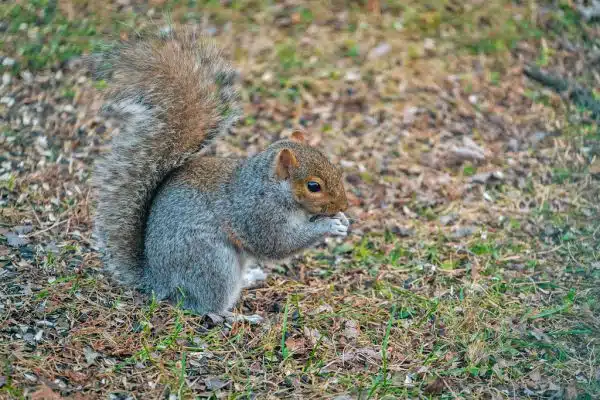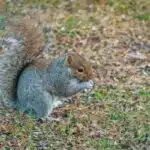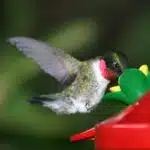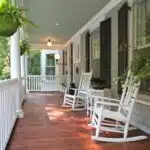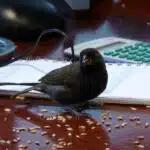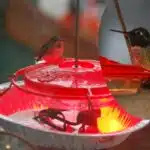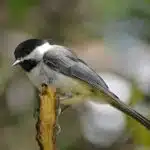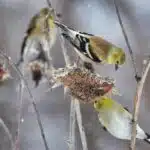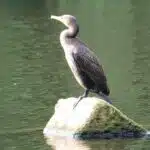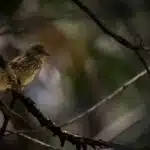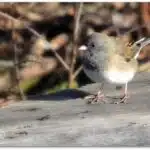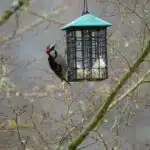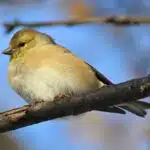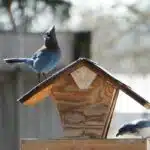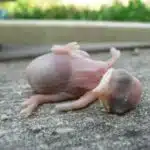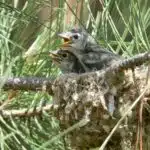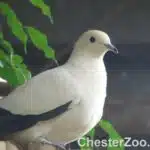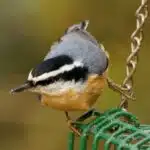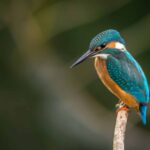Bird feeding is a popular pastime that many people enjoy. It provides a way to connect with nature and observe the fascinating behaviors of birds. However, it can be frustrating when squirrels invade bird feeders and steal the food intended for birds. This issue has led to the development of various solutions to keep squirrels out of bird feeders.
As wildlife conservationists, we understand the importance of maintaining a balance between human activities and nature. While squirrels are adorable creatures, they can become pests when they disrupt natural ecosystems or damage property. Therefore, we have compiled safe and easy tips that will help keep squirrels out of your bird feeders without harming them. By following these tips, you can enjoy watching birds without worrying about squirrel interference while simultaneously serving our feathered friends by providing them with a safe feeding environment.
Understanding Squirrel Behavior
Squirrels are often viewed as cute and friendly creatures, much like the beloved Disney character Chip or Dale. However, when it comes to bird feeders, these furry critters can quickly become a nuisance. They have an incredible sense of smell and dexterity, making it easy for them to climb up poles or jump from nearby trees to access the feeder.
Understanding squirrel behavior is essential in keeping them away from your bird feeders. Squirrels are herbivores and have a varied diet that includes nuts, fruits, and seeds. They communicate with each other through a series of chirps, clicks, and tail movements. They also use scent marking to establish territories and communicate with other squirrels.
Knowing this information can help us understand why squirrels are drawn to bird feeders. The seed inside the feeder may be similar to what they eat in the wild. Additionally, if one squirrel finds food at a particular location, they will communicate this information to other squirrels in their community. Therefore, it is important to take steps that prevent squirrels from accessing your bird feeder so that they do not invite their friends over for a meal.
When it comes to keeping squirrels out of your bird feeders, one of the first steps is choosing the right type of feeder.
Choosing The Right Bird Feeder
- The size of the bird feeder is an important factor to consider when choosing the right feeder.
- Ideally, the bird feeder should be hung in an area that is out of reach from squirrels, preferably a tree or pole.
- The design of the bird feeder should also be taken into account when selecting the most suitable feeder for the intended purpose.
- Bird feeders designed with a weight-sensitive mechanism can be an effective way to keep squirrels from accessing the food.
- Make sure the bird feeder is securely fastened to a tree or pole to avoid it from being toppled by squirrels or other animals.
- Select a feeder that has a wide enough opening to allow birds to come and go without difficulty but small enough to prevent squirrels from entering.
Size
Bird feeders are an essential part of the wildlife conservationist’s arsenal. They enable us to provide food for our feathered friends and enjoy their beauty up close. However, squirrels can be a significant problem when it comes to bird feeders. One solution is to use squirrel feeders in tandem with your bird feeder. This way, the squirrels can have their own food source and stay away from the bird feeder.
Another factor to consider when choosing the right bird feeder is size. The size of a bird feeder can significantly affect its effectiveness in keeping squirrels out. A smaller bird feeder may be more challenging for squirrels to access, as they cannot grip onto it as well as a larger one. Additionally, larger birds tend to require more significant feeding ports or trays to accommodate their size, which can make it easier for squirrels to get inside.
Finally, when selecting a bird feeder, consider the size of the birds you wish to attract. Smaller birds will need smaller feeding ports or holes that are too small for squirrels to fit through comfortably. Conversely, if you want to attract larger birds such as woodpeckers or jays, you may need a more extensive feeder with bigger feeding ports or trays that are harder for squirrels to access. Taking these factors into consideration can help ensure that your bird feeder is effective at keeping squirrels out while still providing nourishment for your feathered friends.
Hanging Method
When it comes to choosing the right bird feeder, one factor to consider is the hanging method. There are various swinging options available in the market, including hanging bird feeders on poles or using a tree branch as an alternative. The hanging method can significantly affect the accessibility of the feeder to squirrels and other unwanted animals.
Using a pole-mounted bird feeder may be more effective at keeping squirrels away than using a tree branch. Poles can be placed far from trees and other structures that squirrels can climb onto, making it harder for them to access the feeder. Additionally, poles with squirrel baffles or guards can provide extra protection against these critters. However, if you prefer using a tree branch as your hanging method, make sure that it is thick and sturdy enough to support the weight of both the feeder and its occupants.
In conclusion, choosing the right hanging method for your bird feeder is crucial in deterring squirrels from accessing it. Whether you opt for a pole-mounted feeder or a branch alternative, ensure that it is secure and out of reach from unwanted animals while still being accessible to your feathered friends. By taking this into account, you can create an environment where birds thrive while keeping pesky squirrels at bay.
Design
The proper design of a bird feeder is essential in attracting birds and keeping them coming back for more. Aesthetically appealing designs can enhance the overall look of your backyard and create a welcoming environment for birds. Furthermore, the material durability of the feeder can ensure that it lasts long enough to provide food for your feathered friends.
When selecting a bird feeder, consider its aesthetic appeal. A visually pleasing design may attract birds to your yard and make them feel at ease while feeding. Be mindful of the color and shape of the feeder as it can affect its attractiveness to different bird species. Additionally, ensure that it is easy to clean and maintain to avoid any potential health hazards.
Aside from its visual appeal, the durability of the materials used in constructing a bird feeder should also be considered. Materials such as wood or metal can withstand harsh weather conditions and last longer than plastic feeders. When purchasing a new feeder, check if it is made from high-quality materials that can withstand wear and tear over time. This way, you not only provide a reliable source of food for birds but also minimize waste in your backyard.
Placing Your Bird Feeder Strategically
After choosing the right bird feeder, it’s important to consider where to place it for maximum bird activity and minimal squirrel interference. Placing your feeder in an open area away from trees and other structures can deter squirrels from accessing it. Squirrels are agile climbers and jumpers, so placing the feeder on a pole with a baffle can also prevent them from reaching the seeds.
Choosing the right birdseed can also make a difference in deterring squirrels. Sunflower seeds are a popular choice among birds but also attract squirrels. Opting for safflower seeds or nyjer seeds can be less appealing to squirrels but still attract birds like finches and cardinals. Mixing in some chili powder with the seed can also deter squirrels without harming them.
Maintenance is key in keeping squirrels away from your bird feeder. Regularly cleaning up any spilled seed or debris around the feeder can discourage squirrels from hanging around. It’s also important to check for any damage or weak spots on the feeder that may allow squirrels to access it. By implementing these tips, you can enjoy watching birds at your feeder without having to worry about pesky squirrels stealing all the seed.
To further prevent squirrel interference, installing a baffle on your feeder pole can be effective. A baffle is essentially a cone-shaped guard that prevents squirrels from climbing up the pole by making it too difficult for them to grip onto. Baffles come in different sizes and materials so it’s important to choose one that fits your specific feeder pole and will withstand weather conditions. With these additional measures in place, you’ll be able to provide a safe feeding spot for birds while keeping pesky squirrels at bay.
Installing A Baffle
Firstly, installing a baffle is an effective way to prevent squirrels from accessing bird feeders. A baffle is a device used to obstruct or deter squirrels from climbing up the pole or jumping onto the feeder. There are two main types of baffles: pole-mounted and hanging. Pole-mounted baffles are placed on the pole below the feeder, while hanging baffles are hung above the feeder.
Baffle installation varies depending on the type of baffle being used. For pole-mounted baffles, simply slide it onto the pole below the feeder and secure it in place with screws or clamps. For hanging baffles, attach a hook above the feeder and hang the baffle from it. It is important to ensure that the baffle is positioned high enough so that squirrels cannot jump over it.
There are various types of baffles available in different sizes and materials including metal, plastic, and wood. Metal and plastic baffles tend to be more durable and weather-resistant than wood ones but may also be more expensive. When selecting a baffle, consider factors such as its effectiveness in deterring squirrels, ease of installation, durability, and aesthetic appeal.
Transitioning to using a squirrel-proof feeder can be another step to take in keeping squirrels away from bird feeders. However, it is important to note that even with a squirrel-proof feeder, installing a baffle can further reduce any chances of squirrels accessing bird feeders. With proper installation techniques combined with careful consideration when selecting a baffle type, bird lovers can successfully keep their bird feeders free from pesky squirrels.
Using A Squirrel-Proof Feeder
Squirrel proof feeders are a great investment for any bird lover who wants to keep squirrels at bay. These feeders are designed to keep pesky squirrels from stealing bird food, while still allowing birds to access the seeds inside. There are a number of benefits to using squirrel-proof feeders, including reduced waste and increased bird diversity.
One benefit of squirrel-proof feeders is that they reduce the amount of wasted seed. Squirrels can quickly empty out a bird feeder, causing seed to spill onto the ground below. This not only creates a mess, but it also attracts unwanted pests like rats and mice. By using a squirrel-proof feeder, you can prevent this waste and ensure that your birds get the food they need without attracting other animals.
Another benefit of squirrel-proof feeders is that they can help attract a greater variety of birds to your yard. When squirrels dominate a feeding area, smaller birds may be hesitant to approach for fear of being chased off or having their food stolen. By using a squirrel-proof feeder, you create a safe haven for smaller birds and encourage them to visit your yard.
If you’re looking for an affordable DIY option for creating your own squirrel-proof feeder, there are plenty of ideas available online. Some popular options include adding wire mesh around the feeder or creating baffles that prevent squirrels from climbing up the pole or tree where the feeder hangs. With just a little bit of creativity and some basic materials, you too can enjoy all the benefits of using a squirrel-proof feeder in your backyard habitat.
As we have seen, investing in a squirrel proof feeder has many benefits such as reduced wastage and increased diversity in bird species. For those who prefer making their own feeders at home rather than buying one outright there are numerous DIY ideas available online such as wire mesh or baffles that can be used to deter squirrels from accessing the birdseed. The next step in creating an ideal habitat for your feathered friends is to create a squirrel-proof barrier.
Creating A Squirrel-Proof Barrier
As wildlife conservationists, we understand the importance of maintaining a healthy balance in the ecosystem. However, squirrels can pose a threat to birds by monopolizing bird feeders and scaring them away from their food source. To prevent this from happening, there are several DIY squirrel deterrents that can be used. One effective way is to create a squirrel-proof barrier around the feeder.
Squirrel behavior modification is important when trying to keep them away from bird feeders. Squirrels are agile climbers and jumpers, making it difficult to keep them out of bird feeders. By creating barriers using materials such as PVC pipes or chicken wire, squirrels will find it challenging to climb up and access the feeder. Additionally, placing baffles or cones above or below the feeder can prevent squirrels from reaching it.
Creating a squirrel-proof barrier may require some effort, but it is an effective way to protect your bird feeder from unwanted intruders. It is also important to note that while these DIY squirrel deterrents may work for some time, squirrels are persistent creatures and may eventually find their way back to the feeder. In our next section, we will discuss another alternative for deterring squirrels – opting for spicy foods.
Opting For Spicy Foods
Creating a Squirrel-Proof Barrier is one effective way to keep squirrels out of bird feeders. However, sometimes barriers may not be enough to deter these persistent rodents. In such cases, opting for Spicy Foods can be an alternative solution.
Squirrels have distinct taste preferences and aversions. They tend to avoid spicy foods due to their sensitive taste buds. To use this knowledge as a deterrent, one can mix cayenne pepper or hot sauce with the birdseed. This will not harm the birds but will make the seed unpalatable for squirrels.
There are commercially available spicy deterrents that can also be used in place of homemade remedies. These contain capsaicin, which is found in chili peppers and causes a burning sensation in mammals but does not affect birds. By incorporating spicy deterrence methods, squirrel invasion can be prevented without causing any harm to wildlife populations or compromising on feeding birds.
Transitioning into the subsequent section about ‘adding a squirrel-proof cage’: Another effective way to guarantee that squirrels stay out of bird feeders is by adding a squirrel-proof cage around them.
Adding A Squirrel-Proof Cage
Squirrel proofing accessories are a great way to keep squirrels out of bird feeders. One popular option is a squirrel-proof cage that can be added to existing bird feeders. The cage allows birds to access the feeder while blocking squirrels from getting in.
DIY squirrel proofing is also an option for those who enjoy crafting and want to save money. Building a squirrel-proof cage can be done with materials found at most hardware stores and online tutorials can provide step-by-step instructions. This option allows for customization and creativity in design.
Adding a squirrel-proof cage is an effective way to keep squirrels from stealing bird food, but it is important to remember that squirrels are persistent creatures. It may take some trial and error before finding the right combination of squirrel proofing accessories to keep them at bay. In the next section, we will explore another technique for keeping squirrels away from bird feeders: using a squirrel-proof pole.
Using A Squirrel-Proof Pole
Adding a squirrel-proof cage is one effective way to keep squirrels away from bird feeders. However, there are other options available that can be equally effective in deterring these clever critters. For instance, using a squirrel-proof pole can be a simple yet efficient way to protect the bird feeders from squirrels.
There are different types of poles that you can use to prevent squirrels from accessing your bird feeders. The most common type is the baffle pole, which has a rounded or cone-shaped baffle installed around it. This will make it difficult for squirrels to climb up the pole and reach the feeder. Another option is a telescoping pole, which allows you to adjust the height of the feeder and make it harder for squirrels to reach it.
If you prefer a DIY approach, you can also install your own squirrel-proof pole using materials such as PVC pipe or metal tubing. Make sure to bury the bottom of the pole at least 18 inches deep in order to prevent squirrels from digging underneath it. You can also add a baffle or cone-shaped guard around the pole for added protection.
By using a squirrel-proof pole, you can effectively stop squirrels from climbing up and accessing your bird feeders. This not only protects your investment in bird food but also ensures that birds have access to food without any competition from squirrels. In the next section, we will discuss some additional measures that you can take to further deter squirrels from accessing your bird feeders.
Stopping Squirrels From Climbing
Tree squirrels are notorious climbers and can easily reach bird feeders that are hung on trees. To prevent this, it is important to hang the feeder far enough away from tree branches or trunks. This can be achieved by using a long pole with a squirrel baffle attached to it. The baffle should be placed at least four feet above the ground and six feet away from any structure that could provide squirrels with access to the feeder. A metal cone-shaped baffle is most effective as it prevents squirrels from climbing up the pole and reaching the feeder.
Ground squirrels, on the other hand, are not climbers but they can jump vertically up to three feet high. To prevent them from reaching bird feeders, place them on a tall pole that is at least five feet high. The pole should also be smooth and without any footholds for squirrels to climb up. Another option is to install a wire cage around the feeder to keep ground squirrels out. This will also protect the feeder from larger animals such as raccoons and opossums.
Preventing squirrels from climbing up to bird feeders requires careful planning and execution, but it is worth it in order to protect birds’ food sources. By using proper equipment such as baffles and poles, homeowners can effectively deter both tree and ground squirrels from accessing their bird feeders. In the next section, we will discuss how distracting squirrels with alternative sources of food can further reduce their interest in bothering bird feeders.
Distracting Squirrels With Alternative Sources Of Food
- Providing alternative food sources to squirrels can be an effective way to keep them away from bird feeders.
- Planting foods that squirrels like such as sunflower seeds, corn, and other nuts can be beneficial in distracting them.
- Moving the bird feeders to different locations on a regular basis can help to deter squirrels from frequenting the same area.
- It is important to ensure that any alternative sources of food are placed away from bird feeders.
- By providing squirrels with a different source of food, it can help reduce competition between squirrels and birds for food.
- As a wildlife conservationist, it is important to consider the balance of the local ecosystem when providing alternative sources of food for squirrels.
Provide Alternative Food Sources
In order to keep squirrels away from bird feeders, it is important to provide alternative food sources for these curious creatures. As squirrel deterrents may not always be effective, offering natural foods that attract squirrels can be a great way to distract them from bird feeders. This strategy can help ensure that birds have access to their food without interference from squirrels.
Some natural foods that can serve as alternative sources of nutrition for squirrels include nuts, seeds, and fruits. These items can be placed in designated feeding areas away from bird feeders, in order to redirect the attention of local squirrel populations. Not only does this approach benefit birds by reducing competition for food resources, but it also helps support the health and well-being of local wildlife populations.
By providing alternative food sources for squirrels, we can help create a more balanced and harmonious ecosystem in which all species can thrive. Rather than relying solely on squirrel deterrents or other methods of exclusion, we can take a proactive approach by offering natural foods that are both nutritious and appealing to these furry critters. In doing so, we not only protect our bird feeders but also contribute to the overall health and vitality of our local environment.
Plant Foods They Like
The feeding habits of squirrels are complex and varied, as these creatures have a diverse diet that includes both plant and animal-based foods. While many people may view squirrels as pests or nuisances, they play an important role in maintaining the ecological balance of our natural environments. As such, it is crucial to consider alternative methods for managing squirrel populations, such as providing them with plant-based foods that they enjoy.
One way to distract squirrels from bird feeders is by offering them plant foods that are part of their natural diet. Squirrels enjoy a wide variety of fruits, nuts, and seeds, including acorns, pine cones, berries, and apples. By placing these items in designated feeding areas away from bird feeders, we can encourage squirrels to focus their attention on these alternative food sources instead.
By incorporating plant-based foods into our efforts to manage squirrel populations, we can help ensure the continued health and vitality of local wildlife populations. In addition to reducing competition for bird feeders, providing squirrels with nutritious and appealing food options helps support their overall well-being. By taking a proactive approach to managing squirrel populations through alternative food sources rather than exclusionary measures alone, we can create a more balanced and harmonious ecosystem in which all species can thrive.
Move Feeders Regularly
Another way to distract squirrels from bird feeders is by regularly moving the feeders to different locations. This technique can be effective because squirrels are creatures of habit and will quickly learn where a food source is located. By frequently changing the location of bird feeders, we can make it more difficult for squirrels to locate them.
The benefits of rotating bird feeders go beyond simply deterring squirrels. Moving the feeder around also helps prevent the buildup of waste and debris that can accumulate beneath stationary feeders. Additionally, regularly rotating bird feeders can attract a wider variety of bird species, as birds that may have previously been deterred by competition or territorial behavior from other birds may now feel more comfortable approaching the feeder in a new location.
It’s important to time the rotation of bird feeders strategically. For example, during the winter months when food sources are limited, it may be best to keep the feeder in one location for an extended period so that birds have a reliable source of food. However, during other times of year when there may be more natural food sources available for birds, rotating the feeder more frequently could be beneficial in reducing squirrel interference and promoting diversity among bird species.
Removing Fallen Seeds And Debris
Preventing waste is crucial in keeping squirrels out of bird feeders. Fallen seeds and debris can attract squirrels and other unwanted animals, which can cause damage to the feeder and discourage desired birds from visiting. To prevent this, it is important to choose a feeder that has a tray or baffle to catch falling seeds and debris. This will not only keep your feeder clean but also reduce the amount of waste that attracts squirrels.
Attracting desired birds is another important aspect of keeping squirrels out of bird feeders. Some species of birds are more likely to visit your feeder if it is clean and free from debris. By regularly removing fallen seeds and debris, you create a welcoming environment for these birds and reduce the chances of squirrels taking over. This will not only benefit the ecosystem, but also provide you with an enjoyable experience watching the variety of birds visiting your feeder.
Overall, removing fallen seeds and debris is an essential step in keeping your bird feeder squirrel-free. It not only prevents waste accumulation but also attracts desired bird species while deterring unwanted animals. By implementing this simple measure, you will be able to maintain a clean and healthy feeding environment for your feathered friends while enjoying their beautiful presence in your backyard.
To maintain the cleanliness of your bird feeder, regular cleaning is necessary. In addition to preventing waste buildup, regular cleaning removes any remaining debris that may have accumulated over time. This ensures that your bird feeder remains attractive to desirable bird species while deterring others such as squirrels from invading it.
Cleaning Your Bird Feeder Regularly
As we learned in the previous section, removing fallen seeds and debris is essential to keeping squirrels out of bird feeders. However, regular maintenance of your bird feeder is just as important. This will not only prevent contamination but also ensure that your feathered friends have a safe and hygienic feeding environment.
Regular maintenance includes cleaning your bird feeder on a routine basis. Bird feeders can become breeding grounds for bacteria and fungi if left uncleaned for extended periods. Therefore, it’s crucial to clean them every two weeks or so. Use a solution of warm water and mild soap to scrub all parts of the feeder thoroughly. Rinse with hot water and let it air dry before refilling.
Preventing contamination is equally important because contaminated food can be harmful to birds’ health. It’s best to avoid using moldy or stale seeds as they can carry dangerous toxins that lead to illness or death in birds. Also, keep an eye out for droppings near the feeder or any signs of sick birds, which may indicate an outbreak of disease among them.
Keeping your bird feeder clean and free from contamination is vital for maintaining a safe feeding environment for birds. As we move into the next section, we will discuss monitoring your bird feeder regularly to ensure that it remains squirrel-free while providing a healthy feeding environment for our avian friends.
Monitoring Your Bird Feeder
As a wildlife conservationist, monitoring your bird feeder is essential to keep track of the activity and ensure the safety and well-being of birds. The benefits of monitoring extend beyond just observing the birds; it also helps you identify any problems that may arise, such as squirrel invasion or seed spoilage. Regular monitoring can help you take preventive measures before it’s too late, allowing you to create a sustainable feeding environment for your feathered friends.
However, common monitoring mistakes can lead to negative consequences. One mistake is not checking the feeder frequently enough. Birds require a consistent food source, and if the feeder runs out of seed, they may seek alternative sources, leading them into dangerous situations. Another mistake is not cleaning the feeder regularly. A dirty feeder can harbor bacteria and disease that can harm the birds’ health. Therefore, it’s essential to clean the feeder thoroughly every two weeks with hot soapy water.
By monitoring your bird feeder correctly, you can enjoy the results of a squirrel-free feeding environment while ensuring the safety and health of your feathered friends. Monitoring allows you to detect any unwanted visitors quickly, such as squirrels or raccoons, enabling you to take action immediately before they damage your feeder or harm the birds. With regular checks on seed levels and cleaning schedules in place, you can have peace of mind knowing that your efforts are providing a safe haven for local bird populations to thrive in their natural habitat.
Enjoying The Results Of A Squirrel-Free Feeding Environment
Monitoring your bird feeder is an important step in maintaining a healthy feeding environment for birds. As a wildlife conservationist, it’s important to ensure that our actions do not harm any animals, including squirrels. While they may be pesky and disruptive to bird feeders, there are safe and easy tips to deter them without causing harm.
Firstly, consider the placement of your bird feeder. Squirrels are excellent climbers and jumpers, so it’s essential to hang the feeder at least six feet off the ground and away from any surfaces that they can use as a launching point. Additionally, try placing baffles above or below the feeder to prevent squirrels from accessing it.
Another tip is to make your bird feeding area more squirrel-friendly by providing them with their own food source. Place a squirrel feeder filled with nuts or seeds away from the bird feeder so that they can enjoy their own feeding area without disrupting the birds.
Tips for deterring squirrels without harming them include using spicy or bitter-tasting seed blends in your bird feeder. Birds are not affected by these flavors but will deter squirrels from consuming them. Additionally, creating barriers around the base of the feeder using PVC pipes or chicken wire can prevent squirrels from accessing it.
Enjoying the results of a squirrel-free feeding environment is rewarding for both birds and humans alike. By following these tips and making adjustments to your feeding area, you can create an environment where both birds and squirrels coexist peacefully without harm to either party. Remember always to be mindful of our impact on wildlife and strive towards harmonious cohabitation.
Conclusion
In conclusion, keeping squirrels out of bird feeders requires a comprehensive understanding of squirrel behavior and the implementation of effective strategies. Choosing the right bird feeder, placing it strategically, installing a baffle or using a squirrel-proof feeder are all effective measures to deter squirrels from accessing your bird feeder. Additionally, removing fallen seeds and debris, cleaning your bird feeder regularly and monitoring its usage can help to maintain a squirrel-free feeding environment.
As wildlife conservationists, our role extends beyond protecting birds; we must also ensure that other species in their habitats are not adversely affected. Implementing safe and easy tips to keep squirrels out of bird feeders is just one way we can strike a balance between providing food for birds while minimizing any potential risks to other animals. By following these tips, we can create an environment that benefits both birds and squirrels alike. Remember: it is up to us to protect the natural world around us for future generations.
Image Credits
- “One of Several Squirrels Who Hang Out Under My Bird Feeder” by John Brighenti (featured)

